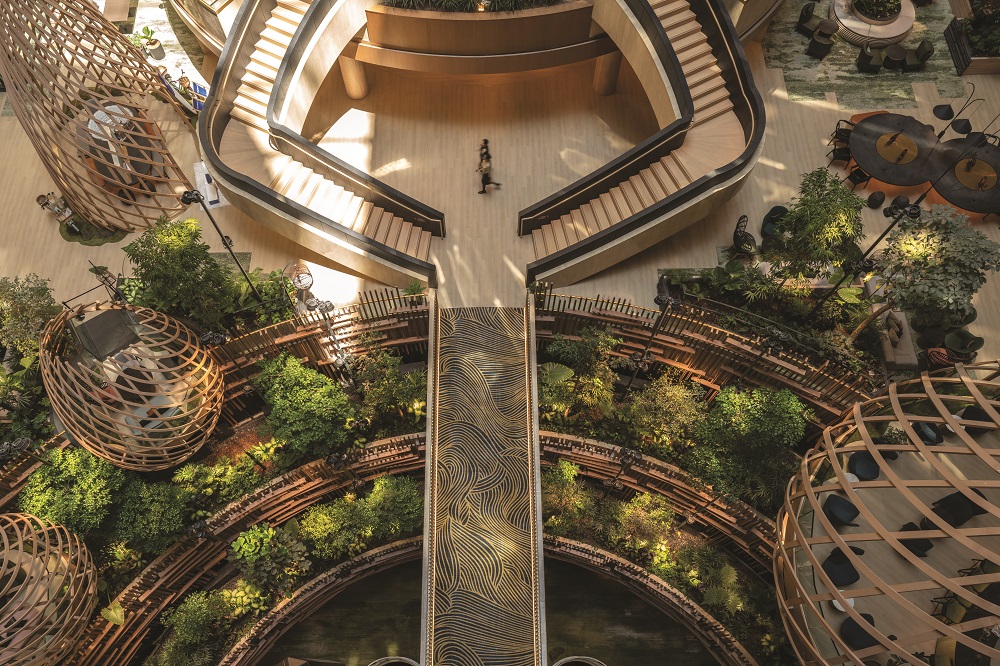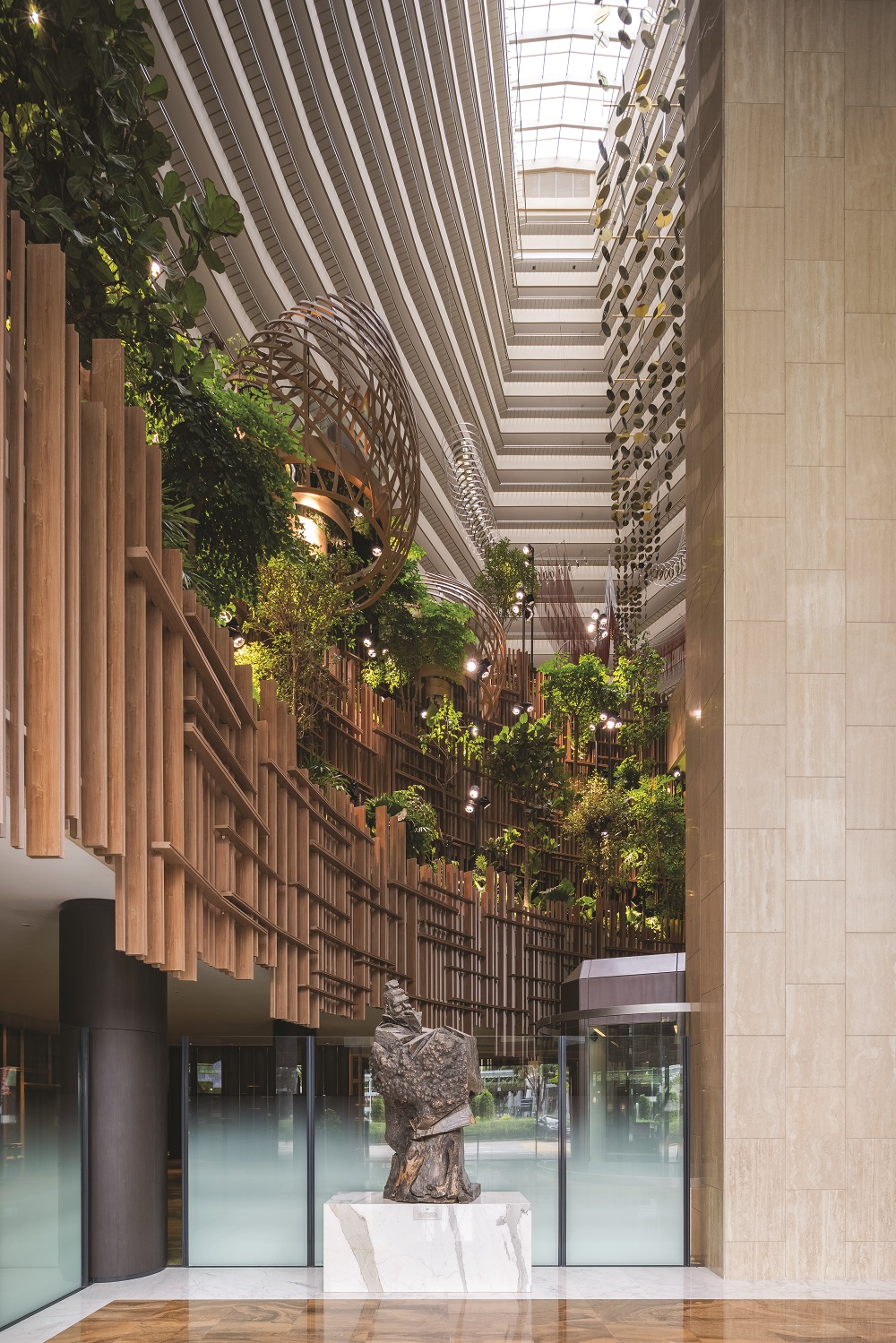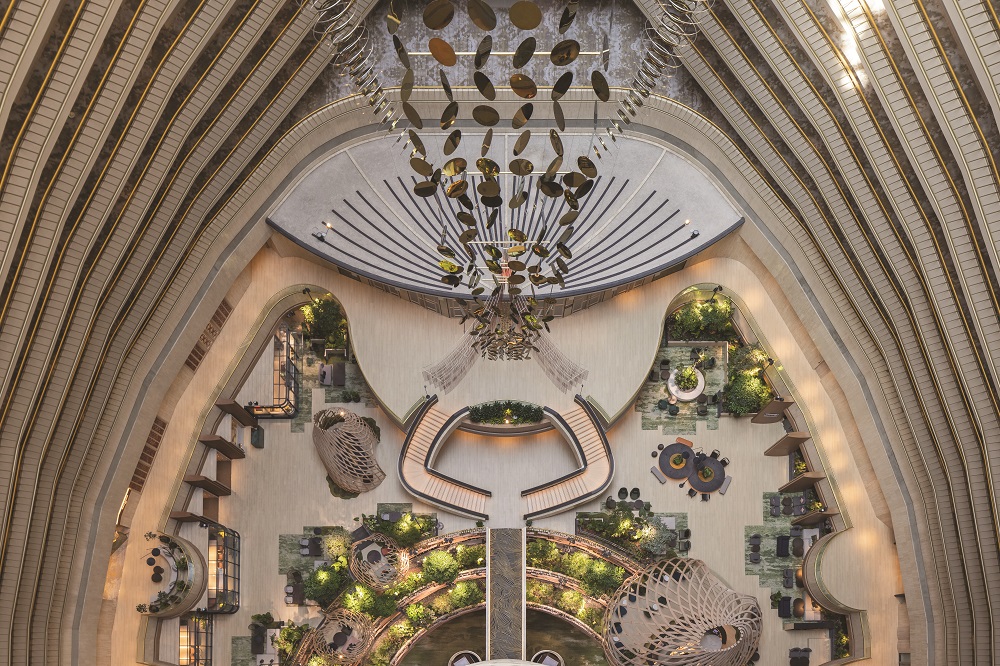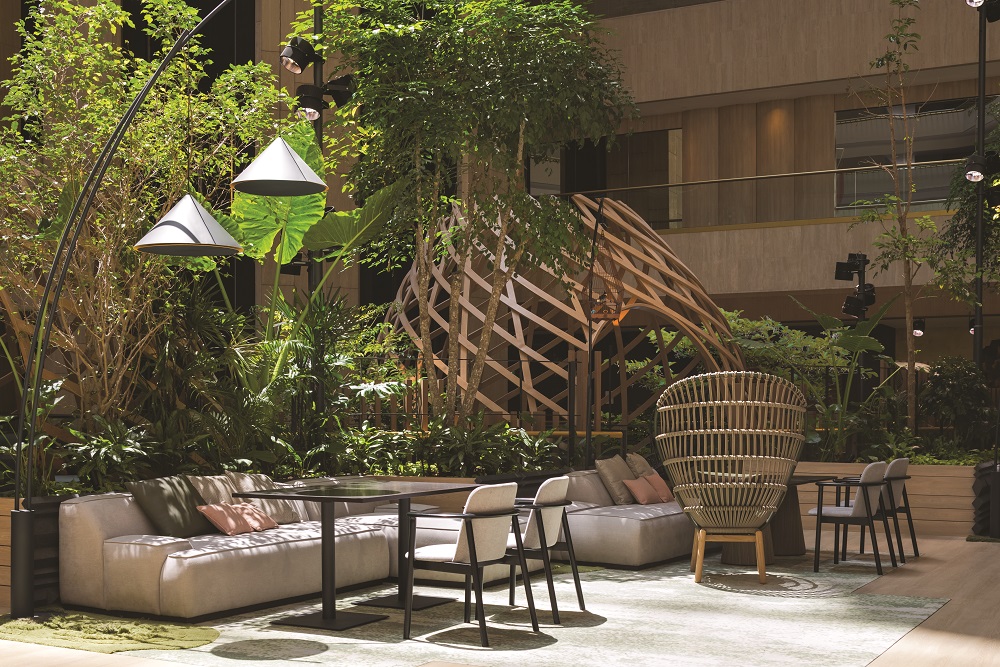Marina Bay Hotel’s green ‘garden in a hotel’ scheme brings fresh vibes into a 34-year-old building.

Atrium architecture draws the eye upward toward cut outs of shifting sun-cloud, day-night effects. This has been the dramatic feature that hotels like the Marina Mandarin Hotel, designed by famed American architect John Portman, offered guests. A recent S$45-million-dollar renovation by FDAT Architects now turns the focus downward — still toward nature, but the view is now of luxuriant greenery, which injects a bucolic atmosphere into the enclosed building.

The hotel has been rebranded by the Pan Pacific Hotel Group (PPHG) into the PARKROYAL COLLECTION Marina Bay under a new segment that focuses on sustainability and iconic design. In Singapore, its other property is the headliner PARKROYAL COLLECTION Pickering with its unusual meshing of glass totems atop a lush, wavy podium, while the PARKROYAL COLLECTION Kuala Lumpur is currently under construction. Also designed by FDAT Architects, the latter promises to impress with a 140-meter biophilic skin woven from 78 sky gardens and planters.
In PARKROYAL COLLECTION Marina Bay, greening goes beyond the token potted plant as embellishment. At the base of the hotel’s original soaring atrium anchored by a stepped podium, nature is made the major narrative. Greenery wraps the lower public spaces, punctuated by enlarged swirling, woven timber lounging alcoves resembling birdcages. At the entrance, a 13-meter landscaped wall makes for a spectacular welcome. The landscaping was conceived by Ramboll Studio Dreiseitl — the international landscape studio behind projects in Singapore, such as the Bishan- Ang Mo Kio Park and Jurong Eco Gardens.

Donovan Soon, a director and co-founder of FDAT Architects, is no stranger to the trending eco hotel model, having worked on the PARKROYAL COLLECTION Pickering while at WOHA Architects prior to coming out on his own. Renovating rather than demolishing the hotel is itself a strong environmental gesture. “One of the tenets of sustainability is not to create unnecessary waste; this applies to buildings as well as plastic bags. Eminent engineer Dr. Hossein Rezai-Jorabi – the founding principal and director of the design engineering consultancy Web Structures — highlights that the demolition of a typical high-rise building emits 51,300 tons of carbon dioxide, which is equivalent to wiping out 10,000 hectares of forests (or 8.7 million trees) — an area larger than all of Singapore’s nature reserves,” Soon comments.
Soon and his team knit together old and new parts in refreshing the dated building. The characteristic stepped volumes at the atrium’s base were repurposed into planters and clad with lightweight timber screens. Guests entering the hotel see six-meter-tall trees amid ample landscaping, which are re-encountered as canopy as they step up to the raised lobby and cross the bridge to the reception area. Features like the birdcage pavilion whose complex twists were conceived with parametric design technology gives the atrium’s grandiose scale more human touch points. “The garden concept works really well in the context. The pavilions create delight and focal points within the amorphous space. The abundant foliage helps soften the large indoor spaces,” describes Soon.

The hotel’s F&B destinations were also redesigned according to the theme. Glass walls express them as glasshouses at the atrium’s perimeter, letting light in while allowing diners to “see and be seen in the lush atrium garden setting,” says Soon. Peach Blossoms, led by award-winning Chef Edward Chong reinvents traditional Chinese cuisine with a light touch, complemented by light wood elements including a wavy entrance ceiling feature. New all-daydining restaurant Peppermint offers farm-to-table dishes in an open-plan space that extends to a terrace where an urban farm grows herbs, edible flowers and vegetables for garnishes, aromatics and ingredients in food and drinks. This and other gestures, such as supplying guestrooms with glass bottles and filtered water instead of plastic bottles of water, as well as employing a food digester to turn food waste into water for gardening, points to the hotel’s dedication to long-term sustainable practices.

In the 583 guestrooms and suites, timber is suitably employed. A timber-clad alcove in some of the guestrooms draws focus to views of Marina Bay, the Padang or city area. FDAT Architects’ customdesigned furniture features have curves that soften surfaces and corners. “Work desks are expressed as horizontal elements, table legs are rounded elements that extend upward to become task lamps. Wardrobes are architectural volumes with timber trellis that float above the door,” says Soon on the pieces’ tectonic expressions.
Hotels have to be refurbished every now and then, but such exercises should go beyond mere beautification. It is a chance to renew perceptions and create unique memories for guests. “In today’s crowded market place, a strong brand message is essential,” affirms Soon. “In hotels, it comes down to the experience — from the big picture down to the details. A relationship with nature is very important — psychologically, as well as environmentally, especially when our cities are getting increasingly dense and built up. Singapore is the ideal test bed and in fact leads the world in many aspects or urban greenery. Land scarcity and a forwardlooking government has driven more innovative approaches to incorporating greenery, which benefit both users and the city.”
